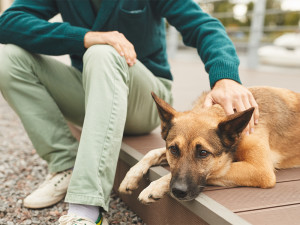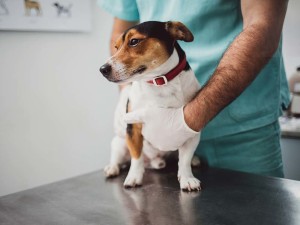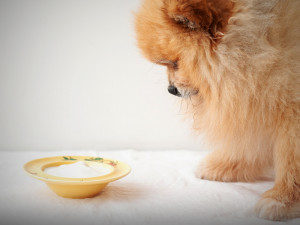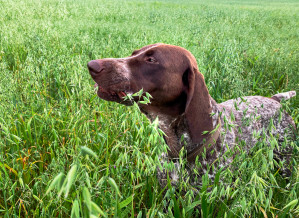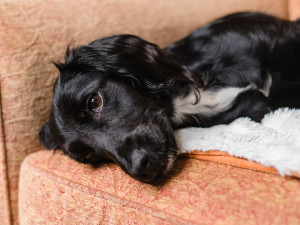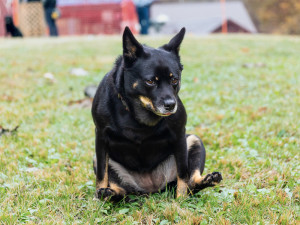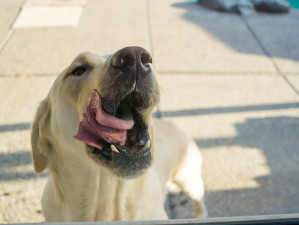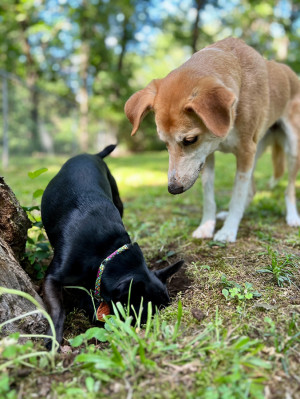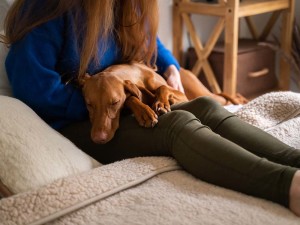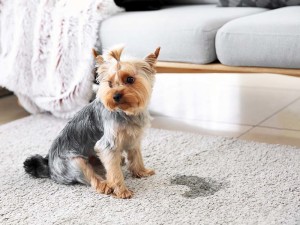Is My Dog’s Poo Normal?
From bloody poo to diarrhoea – all your dog’s poo problems explained
In this article:
How do I know if my dog’s poo is normal? Causes of variation in dog poo Decoding variations in dog poo Home remedies for abnormal poo When to go to the vet for abnormal dog poo Tips for maintaining healthy dog poo
Nothing really fazes dog parents. We wake up the second we hear our pup make a sound like they’re going to throw up. When they are puppies, we stick our hands in their mouths to fish out that piece of rubbish they’ve decided is a snack. And when they poo, we examine it to make sure it looks OK and that they’re healthy. That’s just part of the deal, but it’s important to know the signs of unhealthy dog faeces.
Your dog’s poo can give you and their veterinarian insights into their overall health. That’s why your vet’s office may ask for a stool sample when you make your dog’s annual check up appointment. It’s a good idea to keep an eye on your dog’s poo in general and make note of any changes in colour, content and consistency that could indicate a leather health issue.
How do I know if my dog’s poo is normal?
Wondering what does healthy dog poo look like? Consistency is the number-one thing you should see. Dog stool should generally have the same colour, size and texture every time. Abnormalities in your dog’s poo colour and consistency may indicate an underlying health problem.
What does healthy dog poop look like?
So, what is normal dog poo? Healthy dog poo should be light to dark brown and have a firm consistency. The stool should look the same inside as it does outside – that means no worms or visible parasites – and when you pick up the stool, it shouldn’t leave a trail or any sort of mucus behind. As for how much your dog poos in a single trip outside, the amount should be proportionate to how much your dog ate for their most recent meal.
What are the causes of variation in dog poo?
There are many causes of changes in bowel movements. There are even times when we vets don’t know what causes a significant poo change. Some of the more common causes are:
a poor diet or general dietary changes
stress (known as stress colitis)
infectious disease
inflammatory conditions
obstructive issues
Keep in mind that every dog’s poo is a little different. You should pay attention to your dog’s stools and know what their normal poo looks like so you can more easily detect a change in colour, size or consistency.
How to decode your dog’s poo?
There are all different types of dog poo, and different colours and consistencies can indicate potential underlying health problems. Or a strange-coloured stool can just mean that your dog ate brightly coloured or dyed food. Here are some signs and changes to note when checking your dog’s stool.
1. Streaks of bright red blood and/or mucus
When red mucus discolouration appears on the surface of a mostly normal, formed dog stool, it’s generally caused by inflammation in the large intestine where mucus on the dog poo is secreted to help protect the intestinal lining. While bloody mucus in dog stool does not necessarily indicate an emergency, it’s a good idea to keep a close eye out for further changes in their behaviour and stool.
2. Soft-formed-to-liquid brown diarrhoea
This type may or may not feature streaks of blood, and is often referred to as a ‘cow patty’ or ‘soft-serve ice cream’. This type of poo is slightly more concerning than the last because the stool is softer, however, it’s generally not life-threatening as long as improvement happens within 24–48 hours and there are no other causes for concern. If your dog is acting normally otherwise – eating well, not vomiting, good attitude – you can take a wait-and-see approach. However, if you notice any changes in their behaviour, take your dog to the vet to rule out any underlying infectionopens in new tab or health issue.
3. A large volume of bloody, watery diarrhoea
“Why is my dog pooping blood?” is definitely a question that should cause concern and requires immediate veterinary attention. This is especially critical in smaller dogs because bloody, watery stools can be an indicator of a common condition called haemorrhagic gastroenteritis, or HGE. In this disease, the bloody poo is characterised by red tissue-like chunks often described as ‘raspberry jam’ or jelly-like. If you notice your dog pooing blood, visit your vet immediately.
4. Black, tarry stools
Black dog poo generally indicates bleeding somewhere higher up in the GI tract, such as the stomach or small intestine, which requires an urgent trip to the vet. More specifically, it can signal a bleeding ulcer (often caused by steroid or NSAID use) or more generalised bleeding (from rat poison, heatstroke or an immune-mediated disease). The stool is black due to the presence of digested blood and can indicate that a large amount of blood is being lost. In these cases, I usually recommend blood tests and an ultrasound to better assess the lining of the intestinal tract.
5. Yellow-orange or pasty, light stools
This may indicate the development of liver or biliary disease, or a stool’s too-rapid transit through the small intestine. A more thorough examination and diagnostic tests are in order.
6. Grey, greasy stools
A possible indicator of inadequate digestion and malabsorption of nutrients from the small intestine, this type of stool is typical of exocrine pancreatic insufficiency (EPI) also called maldigestion, a disease in which the pancreas no longer functions as it should. The pancreas is responsible for producing digestive enzymes and without them, nutrients cannot be properly absorbed. Both German Shepherds and Rough-Coated Collies are commonly afflicted with EPI.
7. Green stools
In the emergency department, I’ve seen dogs with green stool, and upon examination of the faecal contents, have discovered the cause to be undigested rat bait mixed in with normal stool. This condition also calls for emergency care. Although relatively uncommon, rat poison can also cause bright, bloody and dark tarry stool, so whether or not you think your dog accessed it, please let your veterinarian know of any possible rodenticide exposure.
8. Worms
Most of the time, you will not actually see worms in dog poo. We typically diagnose worms by looking for their eggsopens in new tab under the microscope – we can tell what type of parasite is present by the shape of the eggs. Occasionally, however, you may see white spaghetti-like shapes in the stool – particularly with puppies – which are typically roundworms.
You may also see small flat worms on the outside of a dog’s stool or rectum, or ‘dried rice’ in their sleeping areas. This typically indicates tapeworms, which take over when fleas flourish. Although seeing worms in the stool is not an emergency, an appointment with your vet is in order so you can get the appropriate medication. ‘Scooting��’ after pooing is another sign that your dog may have worms.
An important note: after a bout of diarrhoea, a dog may not have a bowel movement for 24–48 hours. As long as the dog is doing well otherwise, this can be considered normal.
9. Constipation
Constipation can result from any number of causes, such as a diet lacking in fibre or eating things that aren’t food, like hair, toys, bones and cat litteropens in new tab. If your dog struggles to defecate, you can try to help them out with these ideas for how to make a constipated dog poo quickly:
Massage the abdominal area.
Add a small amount of mineral oil (generally, one teaspoon for 5kg of body weight) to your dog’s food.
Take them for a walk or outside to play.
Constipation can also be a symptom of a more serious issue, like digestive tract tumours, anal gland issues or metabolic disease. If your dog’s constipation persists for more than a few days, contact your vet.
What are the home remedies if noticed unhealthy dog poo?
If you notice your dog’s stool looks abnormal – and you’re not concerned about a potential illness – there are some ways you can help your dog properly digest their food at home and return their bowel movements to normal.
Implement a bland diet
Many people think that when a dog’s suffering from diarrhoea, food should be withheld for 24 hours. That’s not really the case. Food actually helps the gut heal by stimulating cells in the intestinal tract lining. To treat diarrhoea in dogs, simply introduce small and frequent feedings of a bland diet (lean protein, such as boiled chicken or ground meat, mixed with boiled pasta, cooked rice and low-fat cottage cheese or scrambled eggs) over the course of two or three days, and then slowly reintroduce your dog’s regular diet in small amounts.
Try probiotics
Many probiotics are available, and your veterinarian is best suited to give you a recommendation. Many probiotics are available as a palatable powder that can be sprinkled over a meal once daily. A dollop or two of yogurt can also be given with each meal to help restore normal GI flora.
Consider slippery elm
An easy-to-find Western herb, slippery elm is one of my favourite natural remedies. It contains mucilage, a substance that becomes a slick gel when mixed with water, and works by coating the stomach and intestines. It also has antioxidants that help relieve inflammation. Provided as a loose powder or in capsule form, the usual dose is 400mg per 9–13kg of body weight every 8–12 hours. It should be given with water, after your dog takes a drink.
Please note that because slippery elm coats the digestive tract, it will slow down the absorption of other drugs, therefore it must be given two hours before or after other medications.
Avoid anti-diarrhoeal meds
I do not believe in using Imodium or other anti-diarrhoeal medications in dogs. If you have ever resorted to these medications yourself, you know about the painful gas cramps that can accompany them. This happens because the drug essentially forces all that waste matter to stay inside when the body is working hard to eliminate it. There are physiological reasons for diarrhoea, and it is best to allow the natural process to happen. Anti-diarrhoeal medications do not fix the underlying problem, and while your carpet may be cleaner, your pup won’t be happier.
When should I seek veterinary advice regarding my dog’s poo?
If your pet suffers from chronic (long-term and/or frequent) diarrhoea and you don’t see improvement in an episode after 24–48 hours, there may be a bigger issue at hand. Common causes of chronic diarrhoea include:
inflammatory bowel disease
food allergies (which can develop later in life)
tumours in the intestinal tract
digestive disorders
That said, if your dog refuses food or water, vomits, or acts ill or ‘off’ after an extended diarrhoea experience, a trip to the vet is definitely necessary. As with most health issues, it’s far better to rule out problems than to ignore them.
Testing for gut abnormalities usually starts with tests for Giardia and an ova and parasite (O&P) exam, specifically looking for Giardia protozoa. During this evaluation, the laboratory technician will also check for overgrowth of normal gastrointestinal bacteria, which we refer to as clostridial overgrowth. Depending on what is found there, other diagnostics such as blood tests and radiographs may be in order.
How to collect stool samples for dogs
Upon visiting your vet, they may ask you to bring in a stool sample for analysis. A tablespoon is generally plenty. Also, freshness counts – faecal samples less than an hour old give the best results, and a stool that isn’t picked up right away could become contaminatedopens in new tab by the surrounding environment.
Make sure you’re collecting a healthy dog stool, even if you have to get a morning sample, double (or triple!) bag it and keep it refrigerated until your dog’s vet appointment.
Tips for maintaining healthy poo for dogs
Once you’re sure that your dog’s poo is healthy, you want to keep it that way. Here are some tips for maintaining healthy dog stools:
Keep an eye on your dog and what they eat.
Choose a high-quality dog food that meets all of your pet’s nutritional needs.
Add fibreopens in new tab to your dog’s diet.
Make sure that your dog always has fresh water available.
Limit stress in your dog’s life as much as possible.
Frequently asked questions
How often should my dog poo?
Most healthy adult dogs poop at least once a day, but two to three times a day can still be considered normal. Puppies have to go outside much more often and may poop as much as five times a day or more.
How long should dogs hold their poo?
A healthy adult dog can hold their poo for 7–8 hours after eating, though many are able to poo an hour after eating.
How do I stop my dog from eating poo?
A dog multivitamin can be helpful if your dog has a vitamin-B deficiency, or supplements that contain papain, an enzyme that helps with digestion. You can also use taste-aversion products, which are available in the form of treats or a powder you can sprinkle on your dog’s food to make their stools less appealing.
What should I look for in my dog’s poo?
Consistency is the number one thing you should see. Dog stool should generally have the same colour, size and texture every time. Any changes to your dog’s stool could be an indication of an underlying health issue, like a bacterial infectionopens in new tab or parasites.
What if my dog’s poop is too hard or too soft?
A very hard or very soft stool can indicate a serious health issue. If you notice your dog’s poo is abnormally hard or soft, collect a fresh sample and visit your veterinarian.
Should dogs poo always be solid?
Generally dog poop should be shaped like logs and remain compact so it’s easy to pick up. Soft messes or small pellets indicate unhealthy poo.
Is runny dog poo normal?
Runny dog poo is not normal and usually indicates an intestinal problem, so you should see your vet.
Is it normal for my dog’s poo to have a different colour?
Healthy dog poo should be light to dark brown in colour. A different colour can indicate illness or that your dog has eaten something dyed or with a bright colour. For example, an orange stool may result after your dog has eaten carrots. This is why it’s important to monitor your dog’s diet and consumption.
How often should I let my dog out?
At the least, you should let your dog out to go to the bathroom after each meal, so two times a day – but 3–5 times a day is suggested for adult dogs.


